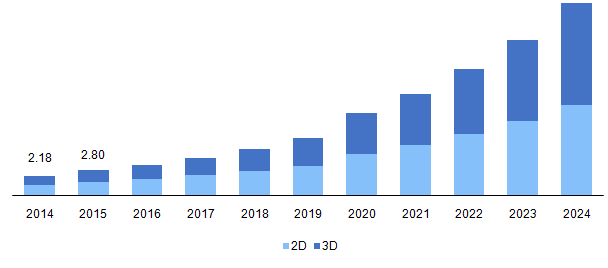
Gesture Recognition Market Analysis By Technology (2D, 3D), By Application (Tablets & Notebooks, Smartphones, Gaming Consoles, Smart Televisions, Laptops & Desktops) And Segment Forecasts, 2014 - 2024
- Published: July, 2017
- Format: Electronic (PDF)
- Number of pages: 100
- Industry: Electronic Devices
Industry Insights
The global gesture recognition market is expected to reach USD 21.1 billion by 2024 on account of rising demand for controlled features in consumer electronics. Growing consumer demand for digitalization in electronics is expected to augment the growth of the gesture recognition/touchless sensing market over the forecast period.
Global gesture recognition market revenue, by technology, 2014 – 2024 (USD Billion)

Gesture recognition eases the level of handling a broad range of devices such as personal navigation devices, computers, laptops and mobile handsets. A growing trend towards touchless gesture recognition in niche applications including gaming is likely to amplify the growth of the touchless sensing market over the projected period.
The sales achieved by electronic devices such as smartphones and tablets over the past few years have resulted in a tremendous growth of the market. The growing demand for electronic devices imbibed with gesture recognition features is expected to propel the growth of the market over the next few years. Companies such as Samsung introduced gesture options on their Galaxy S6 in May 2015. The company’s latest model in the same series also boasts of several gesture features along with face recognition for unlocking the handset.
Inadequate standardization of gesture features and high costs of the technology are expected to hamper the growth of the market over the projected period. Nonetheless, increasing awareness among consumers regarding the advantages of the technology coupled with growing adoption is anticipated to open new avenues for growth over the forecast period.
Segmentation by technology
• 2D
• 3D
2D dominated the global market accounting for over 55% of the share in 2016. Cost-effectiveness of this technology resulted in its wide usage across a host of consumer electronics. However, 3D technology allows consumers to interact real-time with computer-generated characters using skeletal or volumetric models. This feature is particularly gaining immense popularity within the gaming industry.
Companies are expanding to accommodate new technologies such as 3D gesture to provide consumers a real-life experience in virtual spaces and thus, are investing extensively in R&D. These factors are expected to result in above average growth of the segment at a CAGR of 32% from 2017 to 2024.
Segmentation by application
• Tablets & Notebooks
• Smartphones
• Gaming Consoles
• Smart Televisions
• Laptops & Desktops
Gesture recognition was implemented extensively in gaming consoles, with the segment accounting for over 50% share in 2016. Increasing sales of gaming consoles such as Xbox and PlayStation is expected to bolster the growth of the market over the projected period.
Smartphones are expected to witness the highest growth over the projected period on account of increasing implementation of the technology for safety & security purposes. Moreover, the high adoption of digitalization coupled with ease of use of mobile phones is expected to fuel the growth of the market over the forecast period.
Smart televisions are expected to witness above average growth on account of high disposable income of consumers and an increasing trend towards purchasing televisions with the latest technology. The segment is expected to grow at a CAGR of over 28% from 2017 to 2024.
Segmentation by region
• North America
• U.S.
• Europe
• UK
• Germany
• Asia Pacific
• China
• India
• Central & South America
• MEA
North America was the largest market accounting for over 35% of the revenue share in 2016, and the trend is expected to continue over the projected period as a result of a highly prevalent trend towards adoption of technology. The presence of a large-scale consumer electronics market is projected to drive the demand for gesture recognition over the projected period.
Asia Pacific is likely to witness the fastest growth at a CAGR of 32% over the forecast period on account of increasing demand for automation. High disposable income of consumers coupled with the presence of large production base of consumer electronics is expected to result in an incremental demand for gesture recognition over the next few years. The growth of the gaming market in the region is projected to provide further impetus to the growth of the industry.
Competitive landscape
The global market is consolidated in nature with the presence of a limited number of players. This industry represented by numerous big players such as Intel, Sony, Google Inc., and Samsung. Companies are focusing on R&D to refine the technology further and reduce the overall costs.

Choose License Type
- World's largest premium report database
- Transparent pre & post sale customer engagement model
- Unparalleled flexibility in terms of rendering services
- Safe & secure web experience
- 24*5 Research support service
